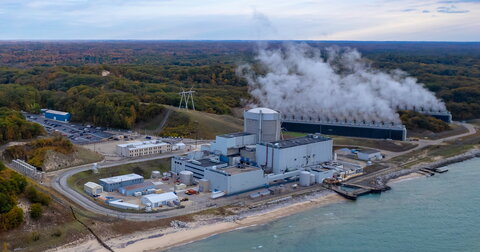Whitmer’s Support Of Nuclear Power Shows How Renewable Energy Has Fallen Short
Asking feds to help keep Palisades nuclear plant’s reactor in service
Gov. Gretchen Whitmer sent a letter last week to the U.S. Department of Energy urging federal money be used to keep the Palisades nuclear power plant open. She called it a top priority, a decision certain to upset her anti-nuclear energy activists in her base. The letter closed with, “I will work with anyone to get this done.”
Whitmer’s decision may show how renewable energy has not been able to replace nuclear power. The Palisades nuclear plant in Covert, Michigan, has been scheduled to be closed since 2017.
In 2016, Consumers Energy reported that it was preparing new renewable energy sources that could replace the energy produced at Palisades when it closed.
In 2019 and 2020, reports from Consumer Energy show that renewables provided 11% of its electricity and nuclear held steady at 8%. That’s the only data available online from the utility.
Statewide, 7.8% of electricity was produced by renewable energy and 28.1% provided by nuclear in 2016. That’s the year in which Consumers Energy said that by 2018 it could replace the electricity provided by the Palisades nuclear plant. By 2018, however, renewable energy was just 8.4% of the state’s electricity mix while nuclear was 26.3%. By January 2022, renewables were at 12.2% and nuclear 25.6%.
Data from the Energy Information Agency shows that Michigan is still depending much more on nuclear power than renewables.
The Michigan chapter of the Sierra Club has opposed nuclear power. Its website states, “The Sierra club remains unequivocally opposed to nuclear energy. Nuclear is no solution to Climate Change and every dollar spent on nuclear is one less dollar spent on truly safe, affordable and renewable energy sources. Help us work to phase out nuclear as quickly as possible.”
On Jan. 14, the Michigan Department of Environment, Great Lakes and Energy, or EGLE, released a draft of a plan that the center-left Michigan League of Conservation Voters called “Michigan’s number one tool that will drive our state’s transition toward clean, affordable energy to achieve carbon neutrality by 2050.” The draft plan put out by EGLE mentioned the term “coal” 11 times but does not include the word “nuclear.” The final version, recently released, had one reference to nuclear power: “Michigan also benefits from a diverse power sector that includes nuclear power plants and the pumped hydro facility at Ludington.”
In Europe, Germany is seeing firsthand the a risk of focusing so much on renewable energy. Wind power was the top source of electricity there, at 22.6% of the total grid load, according to Wind Power Monthly.
The New York Times published an April 5 story, describing the difficulty Germany has in boycotting Russian energy after Russia. The headline: “Why Germany Can’t Just Pull the Plug on Russian Energy."
“Last year, Russia supplied more than half of the natural gas and about a third of all the oil that Germany burned to heat homes, power factories and fuel cars, buses and trucks," the newspaper reported. "Roughly half of Germany’s coal imports, which are essential to its steel manufacturing, came from Russia. Russian gas, oil and coal are embedded in the German economy and way of life. The roots run deep.”
Michigan Capitol Confidential is the news source produced by the Mackinac Center for Public Policy. Michigan Capitol Confidential reports with a free-market news perspective.

